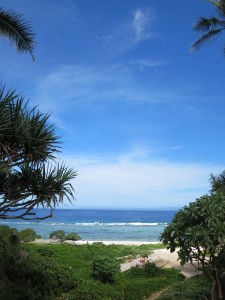Nuku’alofa, the capital city of Tonga, located on the island of Tongatapu, felt roaring in comparison to Vava’u. (Just wait till I tell you about Suva.) Because our arrival was delayed by a storm (a low pressure system that made the waves seem incredibly huge and dangerous to us students, but the pro crew weren’t phased by at all), the various programatic/school-like things planned fell apart a little bit. Despite that, we did make the best of our time there.
A trip to the Ministry of the Environment resulted in a small group of students visiting one site that’s part of a mangrove planting project along the edge of a large lagoon on the island. The project aims to reduce coastal erosion as well as involve local communities. After being raised in a nursery, they are brought young mangrove plants are brought to the project location. Tonga has about 10 indigenous types of mangroves, each of which are better suited for different locations. If there is more water in the soil, one species will do, but if there is a lot of hibiscus and consequently a lot of shade, a different type will be planted.
On the cultural side of our studies, a bus tour if the island brought us to some cool archeological sites before bringing us to an incredible series of caves with freshwater. It’s a tucked-away swim spot just yards from a gorgeous beach. Even though we’re supposed to be studying environmental and cultural sustainability and learning about the histories and cultures of these islands, we somehow always find our way to a stretch of gorgeous sand and crashing water. While it’s not every day we postpone the rest of our afternoon plans for some surprise beach time, some afternoons I do need to remind myself that I’m technically at school.
We students streamed in to the caves, ducking under a low hanging entrance and winding around stalagmites and stalactites. Many somethings–maybe bats, maybe birds chattered all along the ceiling of the caves. (I think mostly birds. I could see their nests, but some students swear they saw bats.)
Very quickly, it was clear that these caves were not only a place to swim, but also a place for cliff jumping. Some folks, who I guessed were neighbors of the family who owned this land, had clambered up a pile of rock in the center of the cave and were jumping into the water from fairly high up. Something about the gloom of the cave, the jagged texture of the rock and the looming ceiling set some alarms off in my head. Maybe some folks have no trouble jumping from high places into bodies of water they are unfamiliar with, but that’s not me. I’ve passed up cliff jumping opportunities before because jumping from heights is scary. Like, I avoided the high dive when I was a kid, probably still would. Add in a close ceiling and plenty of dark rock just waiting for a bad landing. Well.
Most of my fellow students didn’t have this hesitation. They dropped their packs, climbed up to a spot maybe 2 meters up or even to a spot 5 meters up, and jumped right in. I hovered, frozen, in the path to the lower ledge. Panicky. Trying to remind myself sternly that this was the only time I’d be here with these people, and I should just ignore all that fear and jump. But I couldn’t quite take those last few steps. Wonderful as our community on the ship is, my friends did not hesitate to encourage me when they realized I was nervous. Except, the prospect of having 30 separate people each individually tell me that I’ll regret not jumping into the water and then watching to see what I would do is just a touch overwhelming. So I left the cave. Retreated to the beach. Dropped my backpack, kicked off my Chacos, and waded into the water. Once it was past my knees I dived the rest of the way into the ocean. Immediately, I felt better. Lighter. Calmer. Water, as always, is a comfort.
Eventually, everyone else poured out of the cave, and I went back with a shipmate. I climbed to the low spot (because high dives are still way scary) and jumped into the water. Yes, it was fun and incredible and worth it. But fear and anxiety are real things. And not so easily ignored. And I’ve run into it a lot on this trip.
When the Seamans is on a consistent heel, I feel like my six year old self learning how to sail on a lake in Minnesota. It is very windy and our tiny boat is heeled over and the water is so close. Or once when we were told about a low pressure system passing through the area and I remember how much I feared storms as a kid. A crew member remarked that “you will break before the ship does.” So I took a deep breath and trusted the boat.
In the caves, I took a deep breath and jumped into the water.



